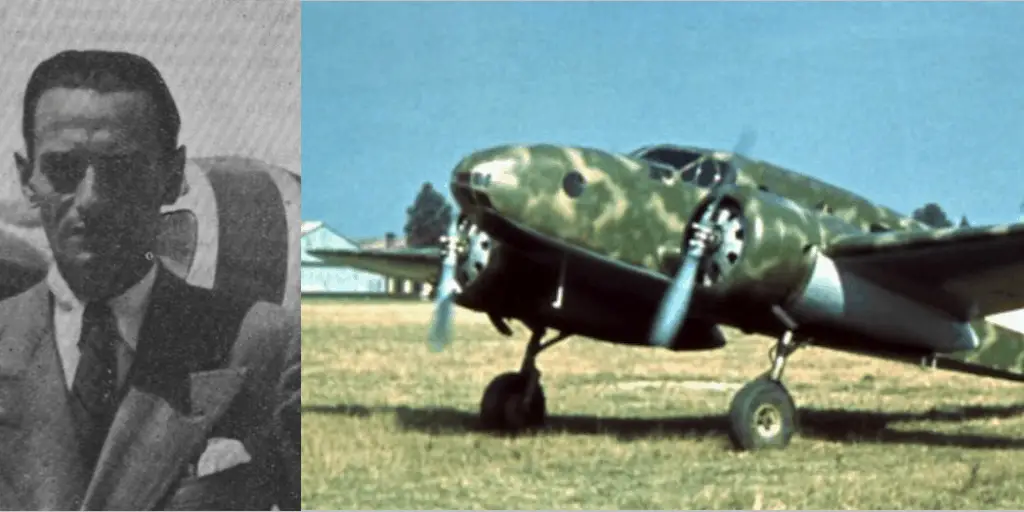The Caproni Ca.310 was an Italian reconnaissance and light bomber monoplane first flown on 20 February 1937 and retired from service in 1948.
Background on the Caproni Ca.310
Although the Ca.308 Borea civil transport and its Ca.309 Ghibli multi-role colonial warplane half-brother clearly possessed production potential in their basic forms, Cesare Pallavicino believed a revised and upgraded power plant and retractable main landing gear units was more marketable. This upgrade would be for the military rather than civilian use. Caproni encouraged Pallavicino to design this aircraft in parallel with the Ca.309. The result was the Caproni Ca.310 Libeccio which first flew as a prototype in 1937 with a modified and strengthened Ca.309 airframe.
Design
The Caproni Ca.310 fuselage comprised of welded steel tube construction with light alloy panels and fabric. The tail section is of wooden construction with a plywood skin on its fixed portions and fabric covering on its moving portions.
The Ca.310 has a cantilever low-set wing of plywood covered wooden construction with virtually the full span of its trailing edges occupied by outboard ailerons and inboard split flaps. Thus the only major change included the forward fuselage and the engine nacelles. A revised forward fuselage incorporated a more effective bombardier position with heavily framed but more extensive glazing on its lower part. The revised engine nacelles provided accommodation for a different power plant and main landing gear units that hydraulically retracted rearward to rest in the underside of the nacelles with only part of each wheel exposed.
A more modest change was the addition above the fuselage, in line with the wing trailing edges, of a manually operated dorsal turret armed with a single rifle-caliber machine gun. This signaled Caproni’s realization that while the Ca.309 would not be required to face aerial opposition in colonial warfare, the Ca.310 would almost certainly face such a threat. The upgraded power plant comprised two 460 HP Piaggio Stella P.VII radial engines.

A camouflaged Caproni Ca.310 conducting reconnaissance.
Exported Models
The Caproni Ca.310 originated as an export model, but the Regia Aeronautica ordered a small batch for evaluation purposes. Spain received 16 of these aircraft in July 1938 for operational trials with the reconnaissance bomber squadron of the Italian expeditionary force operating alongside the Nationalist insurgents in the Spanish Civil War. Caproni achieved more success in the export market, capturing orders for Peru for a small batch delivered in 1938; Yugoslavia for 12 aircraft; Hungary for 36 aircraft delivered in batches of 12 from August 1938 to October 1938 with a power plant of two 460 hp P.VII C.35 radial engines; and Norway requested up to 24 aircraft.
Canceled Orders
Most of these countries soon discovered that the actual performance of the Caproni Ca.310 fell below its specifications. and after discovering this fact with its first four aircraft Norway refused to accept any further deliveries of the Ca. 310, but then agreed to take 12 examples of the Ca.312 whose upgraded power plant offered improved performance. In any event, none of these 32 aircraft had been delivered before Norway was invaded by German forces in April 1940 and the aircraft was taken on charge by the Italian air force. Hungary was also unhappy with its Ca.310s. In 1940, the surviving 33 aircraft were returned to Italy which Caproni refurbished and reissued to the 50th Stormo d’Assalto as temporary replacements for the group’s unsatisfactory Breda Ba.65 attack aircraft.
British Interest
Great Britain was potentially the most important customer for the Ca.310, which was undertaking a major expansion of the RAF in a program that accelerated after the Munich Crisis of October 1938. A major element in this British program included enlarging the bomber force, which required an effective crew trainer aircraft. The British decided that the Ca.310 could fit this role in late 1938. Protracted negotiations continued until after the outbreak of World War II when Italy was still neutral. In December 1939 the British government informed Caproni it was planning to buy 200 examples of the Ca.310 and 300 examples of the more powerful Ca.313. Eventually, the British decided to replace its planned force of 200 Ca.310s with 100 Caproni Ca. 311s.
Variants
- Ca.310 Idro: A twin-float seaplane version of the Ca.310.
- Ca.310bis: Caproni Ca.311 prototype.
Specifications
| Model | Caproni Ca.310 |
|---|---|
| Crew | 3 Pilot, Co-Pilot/Bombardier/Dorsal Gunner and Radio Operator/Gunner |
| Powerplant | (2) Piaggio P.VII C 35 radials 760 HP at 3800 mt (each) |
| Maximum Speed | 227 mph (365 Km/h) at 5250 m |
| Max Ceiling | 22,966 ft (7,000 m) |
| Range | 1,050 miles (1,690 km) |
| Length | 40 ft (12.2 m) |
| Height | 11 ft 6 in (3.52 m) |
| Wingspan | 127 ft (38.7 m2) |
| Weight | Empty: 6,702 lb (3,040 kg) Max: 10,251 lb (4,650 kg) |
| Armament | (3) 7.7 mm Breda SAFAT machine guns (2 )× 7.7 mm forward in the wing roots, (1) × 7.7 mm in a dorsal turret |
